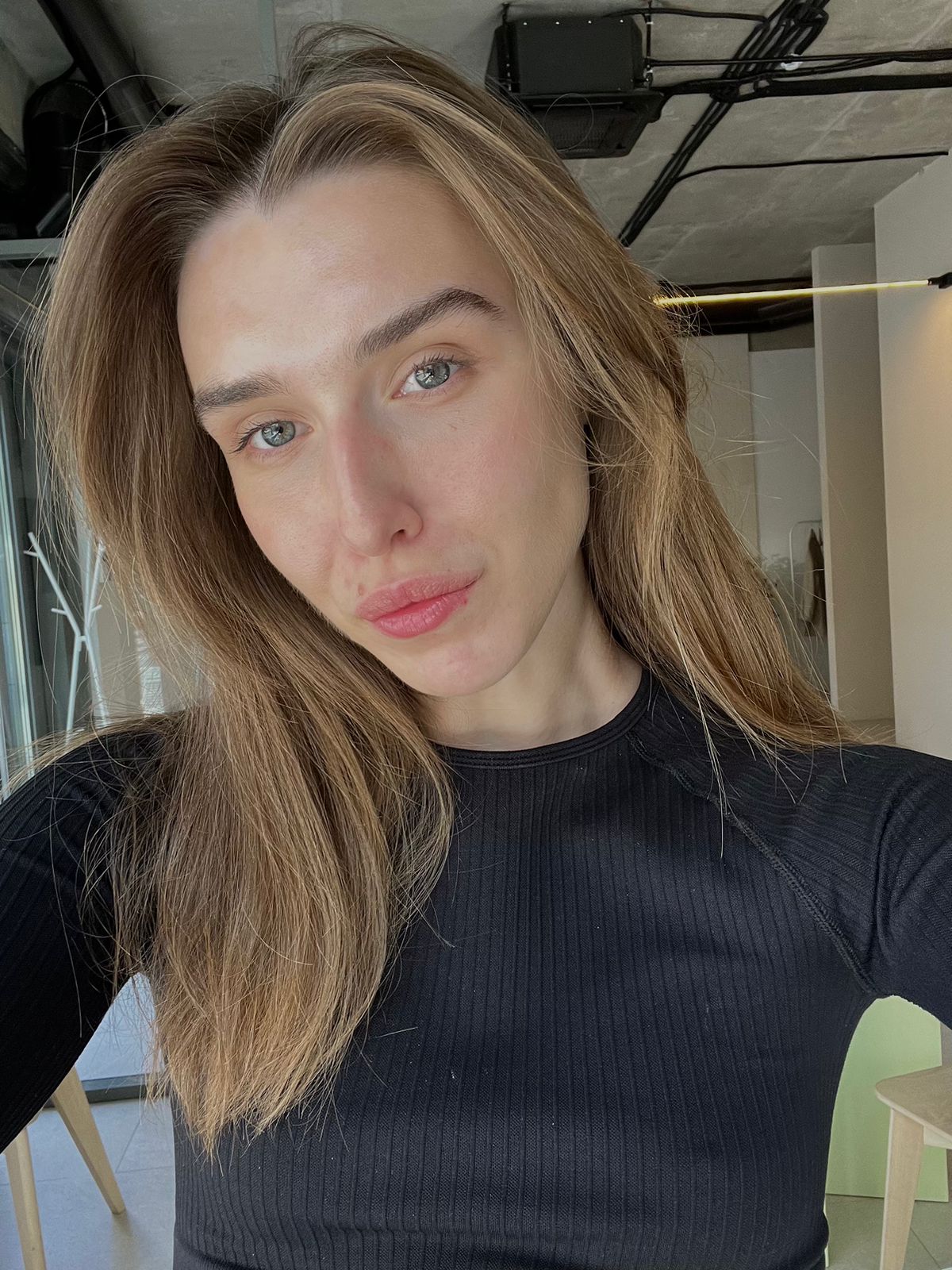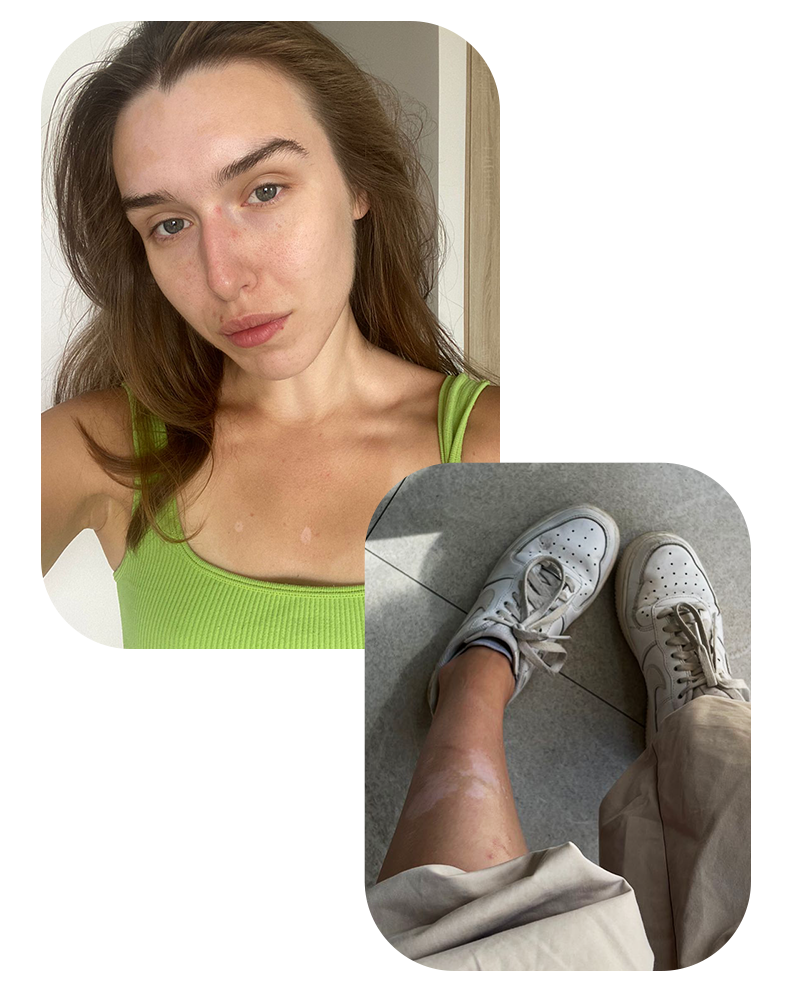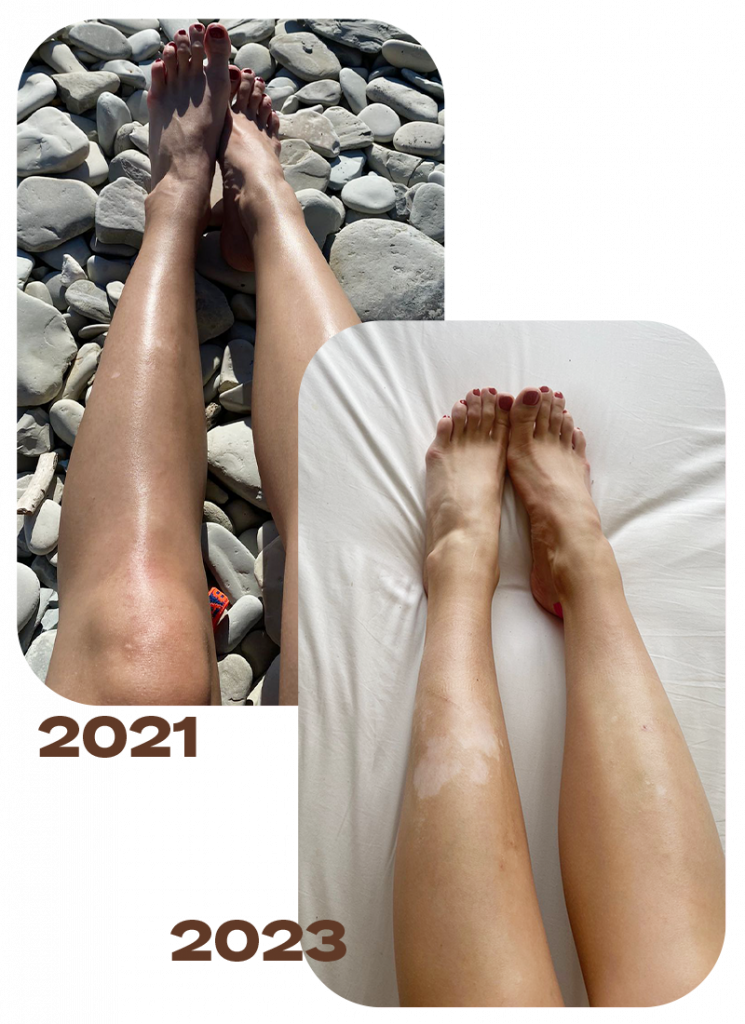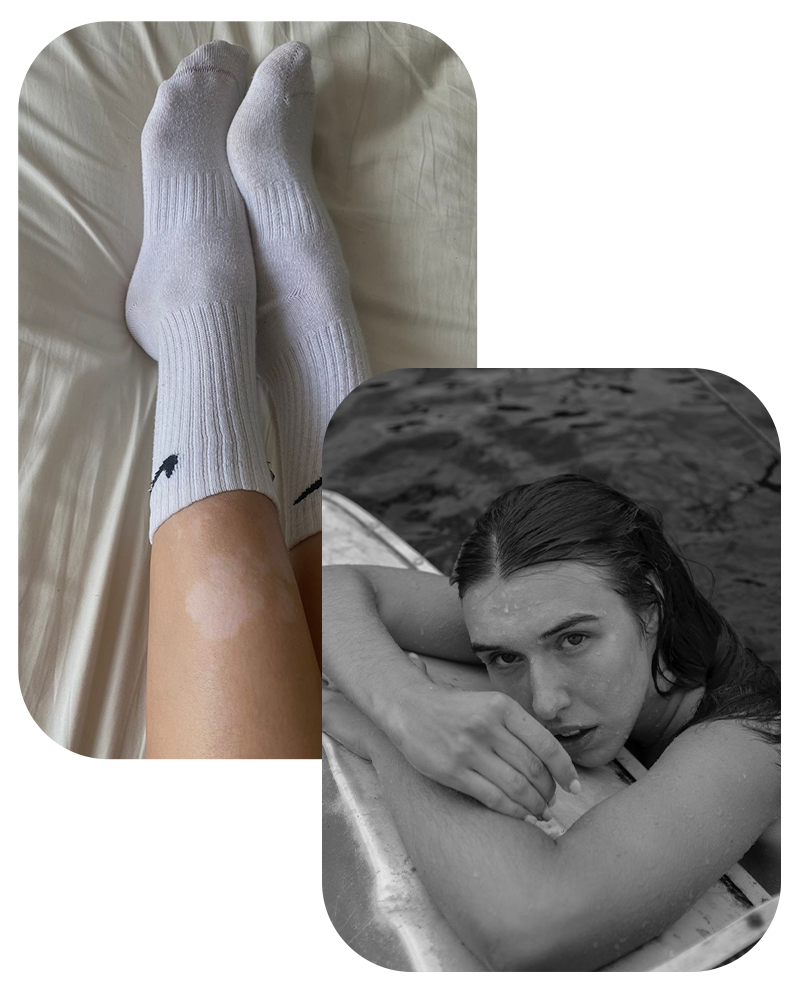We continue to talk about people who do not meet traditional standards of beauty, but have the appearance characteristics that we see in them. You can read the story of model Tonya Rybkina living with Sturge-Weber syndrome here.
And today we would like to give the floor to Anna Chelnova, beauty journalist, triathlete and author of the Sportshik Telegram channel. mucous membranes. Then comes the direct speech.

Anna Chelnova
In August 2020 I noticed strange white spots around moles on my stomach. At that moment I did not attach any importance to this – we were resting on the Black Sea coast, and then it seemed like such a reaction to the sun. At 20, I ignored the advice of dermatologists and sunbathed for hours without protection – it was so good that I didn’t want to think about safety.

A year later, in June 2021, I ran out of competition. And the next day I discovered my resemblance to the leopard. In places of moles – white spots. There are white dots next to the scars. There are white dots above the eyebrows. On the cheeks – all the same white dots.
It turns out that this is not just an uneven tan, but vitiligo.
What is vitiligo and how does it appear?
Vitiligo is a dermatological disease characterized by discoloration of the epidermis. Discoloration occurs due to the destruction or sharp decrease in the number of melanocytes in the lesions. Simply put, the skin loses its pigment and ability to tan.
Scientists have not yet decided whether vitiligo is acquired or congenital, but there is a fact that overlaps with all the controversy – there is no proven effective method for the treatment of vitiligo. Moreover, this disease progresses over the years and more and more white areas appear in the human body.
But there is good news: vitiligo is not dangerous, it is not a disease in the classical sense. I can say that vitiligo is a feature – it does not bother me in any way, except for aesthetic moments.
At the time of the manifestation of vitiligo, I was 20 years old. Studies show that the disease can manifest itself at any age from birth to old age, while vitiligo is diagnosed in 0.5-1% of the population.
What causes vitiligo?
There are many theories: genetics, autoimmune, oxidative stress, neuroendocrine. One thing is important here – if there is no clear cause of the disease, it is very difficult to find a treatment algorithm.
I had many assumptions: hyper facial skin care, strong sun exposure, stress, hormonal failure, ecology. Then in the summer of 2020 I experienced severe stress, which also affected the hormonal background. This could be the trigger.

When I noticed that the spots began to grow, I turned to Maria Yakubovskaya, the dermatologist of the Danimed clinic.
According to the doctor, I could not avoid vitiligo.
Recent research would reveal that vitiligo is still a genetic inheritance and sooner or later it will reveal itself anyway. Hyper-care, overexposure to the sun and the environment may not be the cause of the disease, but stress is quite possible as a trigger.
How does vitiligo manifest itself?
The symptoms are pretty obvious.
– Irregular or light white patches.
– Lack of pigmentation on the hands, near the ears, eyes, mouth and nose.
– Small light spots on the skin.
There are also some pretty funny symptoms – for example, my nipples have turned different colors (one dark, the other pale pink, almost white) and my body hair has turned gray.
How has my life changed since vitiligo started?
I became “you” with the sun: whitened skin burns very easily, so vitiligo owners should not really sunbathe. You will get a full-fledged burn instead of the luminous zone, while the rest of the skin will be in perfect order.
In addition, white spots appear from contact with the sun. So, for example, instead of small spots on my forehead, a full-fledged focus of vitiligo appeared, occupying about a third of my face.
Measures I have taken
– Every day from March to October, in any weather and mood, I apply at least 50 SPF protection.
– I integrated caps and panama hats into my wardrobe. The main points of vitiligo are on my face, so I try to cover it.
– She cut off her bangs. Here’s a win-win – and spots appear less often in the sun, and attention turns to the hairstyle.
– I started training in the evenings when the UV index fell below 3.

I have pretty fair skin, so my face has vitiligo only in summer. In the fall, when the sun goes down, I actively add glycolic acid and vitamin C to my skincare to brighten the skin, and in three to four weeks all tan marks and spots with them are gone.
If you protect yourself from the sun, the contrast between the affected and healthy skin will be small. I need BB cream over sunscreen to cover it up.
Sometimes what is frustrating is the bright foci of vitiligo on the body – I will never have an even skin tone on my legs, and the spots themselves attract inappropriate attention and questions.
Maybe there is a cure for vitiligo?
“It is impossible to get rid of vitiligo completely. This is a chronic process, but it is possible to treat and prevent the appearance of new lesions. When a red spot appears, it is necessary to prescribe a hormonal ointment with corticosteroids. Phototherapy has proven effective for working with vitiligo foci that have already formed. If you’re diagnosed with vitiligo, the most important thing is to use sun protection with SPF 50+,” says Marina Yakubovskaya, a dermatologist at the Danimed clinic.
If you already have vitiligo, how can you stop the progression of the disease?
Dermatologist Sergei Agapov writes in his article “Vitiligo – Symptoms and Treatment” that it is possible to stop the progression of vitiligo.

Should I try to treat vitiligo?
As the authors of the article “Algorithm for the treatment of vitiligo” say, it all depends on the psychological state of the person. If you are not worried about uneven skin tone, you should not test your wallet and liver for strength – with all the tests, treatment is expensive and taking any medication (including vitamins) strains the liver, and in this case it is unfair.
If vitiligo gives you a lot of moral discomfort, you need to prepare for a long and possibly not very effective treatment. They may prescribe phototherapy (currently this method is the most effective), ozone therapy or cardiomagnyl. But not all these methods have been proven and this is more of a way for the sake of a way than a cure.
And what to do next?
As a medical center marketer, it makes perfect sense to me that many clinics “cure vitiligo” – this disease is driven by appearance, which is a very intimate and important part of life. Therefore, many people are ready to spend years and millions to get rid of whiteheads. To pass tests for tumor markers, check the thyroid gland, look at the stomach, send for acupuncture – such a set will come out in a round sum and will take a lot of time.
For this reason, if you have suffered from vitiligo at a young age, I recommend that you love every bit of you and continue to use sunscreen actively. If the disease appeared much later than adolescence, it makes sense to go to an endocrinologist – vitiligo may be the result of a malfunction in the thyroid gland. But even in this case, you have to deal with the root cause and the white dots will most likely be with you forever.
One time my friend took a long look at my face and said: “You know, An, you are incredibly beautiful with these spots.” And I believed him. I try to accept this side of myself and love it. After all, vitiligo can be a very beautiful feature of your body if you so desire.
Source: People Talk
I’m Roger Gritton, and I’ve been writing for the The Fashion Vibes for over 5 years now. My specialty is beauty news; I’m passionate about covering the latest trends, products, and innovations in the industry. In my time there, I’ve become known as an authority on all things beauty-related.
I love discovering new experts to interview, researching up-and-coming ingredients and techniques that are making their way onto our beauty shelves and highlighting people who are making a difference in the world of cosmetics. My work has appeared not only on The Fashion Vibes, but also several other publications including the New York Times Magazine, Allure Magazine and Refinery29.





